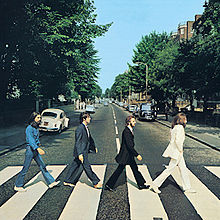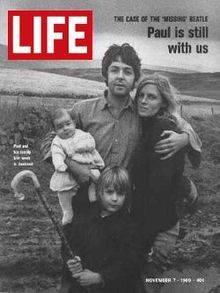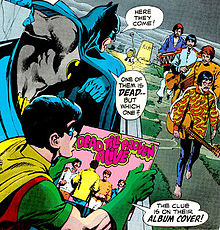- Paul is dead
-
"Paul is dead" is an urban legend suggesting that Paul McCartney of the English rock band The Beatles died in 1966 and was secretly replaced by a look-alike.
In September 1969, American college students published articles claiming that clues to McCartney's death could be found among the lyrics and artwork of The Beatles' recordings. Clue hunting proved infectious and within a few weeks had become an international phenomenon. Rumours declined after a contemporary interview with McCartney was published in Life magazine in November 1969. Popular culture continues to make occasional reference to the legend.
Contents
Beginnings
A rumour that Paul McCartney had been killed in a car crash circulated in London after a January 1967 traffic accident involving his car. The rumour was acknowledged and rebutted in the February issue of The Beatles Book fanzine,[1] but it is not known whether the rumour of 1969 is related to it.[2] In the autumn of 1969, The Beatles were in the process of disbanding; McCartney's public engagements were few and he was spending time at his Scottish retreat with his new wife Linda in order to contemplate his forthcoming solo career.[3][4]
On 17 September 1969, an article titled "Is Beatle Paul McCartney Dead?" was published in the student newspaper of Drake University in Iowa. The article described a rumour that had been circulating on campus that Paul was dead. At that point the rumour included numerous clues from recent Beatles albums, including the "turn me on, dead man" message heard when "Revolution 9" from the White Album is played backwards.[5] In wire reports published as early as 11 October, Beatles press officer Derek Taylor responded to the rumour saying "Recently we've been getting a flood of inquiries asking about reports that Paul is dead. We've been getting questions like that for years, of course, but in the past few weeks we've been getting them at the office and home night and day. I'm even getting telephone calls from disc jockeys and others in the United States."[6]
Growth
On 12 October 1969, a caller to Detroit radio station WKNR-FM told disc jockey Russ Gibb about the rumour and its clues. Gibb and other callers then discussed the rumour on the air for the next hour. Two days after the WKNR broadcast, The Michigan Daily published a satirical review of Abbey Road by University of Michigan student Fred LaBour under the headline "McCartney Dead; New Evidence Brought to Light".[7] It identified various "clues" to McCartney's death on Beatles album covers, including new clues from the just-released Abbey Road LP. As LaBour had invented many of the clues, he was astonished when the story was picked up by newspapers across the United States.[8] WKNR-FM further fuelled the rumour with a special two-hour program on the subject, "The Beatle Plot", which aired 19 October 1969 (and in the years since on Detroit radio).
In the early morning hours of 21 October 1969, Roby Yonge, a disc jockey at New York radio station WABC, discussed the rumour on the air for over an hour before being pulled off the air for breaking format. At that time of night, WABC's signal covered a wide listening area and could be heard in 38 states and at times, other countries.[9] Later that day, The Beatles' press office issued statements denying the rumour which were widely reported by national and international media.
Various ‘clues’ were used to suggest the following story: three years previously (on 9 November 1966), McCartney, after an argument during a Beatles' recording session, had angrily driven off in his car. He had crashed it and died as a result. To spare the public from grief, the Beatles replaced him with "William Campbell", the winner of a McCartney look-alike contest.[10]
The "clues"
Hundreds of supposed clues to McCartney's death were reported by fans and followers of the legend; these included messages perceived when listening to a song being played backwards, and symbolic interpretations of both lyrics and album cover imagery.[10] One oft-cited example was the suggestion that the words spoken by McCartney's band-mate John Lennon in the final section of the song "Strawberry Fields Forever" are "I buried Paul". McCartney later revealed the words were actually "cranberry sauce."[11] Another was the interpretation of the Abbey Road album cover as symbolising a funeral procession, with "John, dressed in pure white, symbolises the preacher or heavenly body. Ringo, dressed in full black, symbolises the mourner. George, in scruffy denim jeans and shirt, symbolises the gravedigger and Paul, barefoot and out of step with other members of the band, symbolises the corpse."[10]
Rebuttal
On 21 October 1969, The Beatles' press office issued statements denying the rumour, deeming it "a load of old rubbish"[12] and saying that "the story has been circulating for about two years—we get letters from all sorts of nuts but Paul is still very much with us."[13] Rumours started to decline when,[14] on 7 November 1969, Life magazine published a contemporary interview with McCartney in which he said,
“Perhaps the rumour started because I haven't been much in the press lately. I have done enough press for a lifetime, and I don't have anything to say these days. I am happy to be with my family and I will work when I work. I was switched on for ten years and I never switched off. Now I am switching off whenever I can. I would rather be a little less famous these days.”[4]
Aftermath
Before the end of October 1969, several records were released on the subject—including "The Ballad of Paul" by the Mystery Tour, "Brother Paul" by Billy Shears and the All Americans, and "So Long Paul" by Werbley Finster, a pseudonym for Jose Feliciano.
Terry Knight, a singer on Capitol Records, had witnessed the Beatles' White Album session during which drummer Ringo Starr had walked out and, in May 1969, released a song called "Saint Paul" about the impending break-up of The Beatles. The tune nosed onto the Bubbling Under Hot 100 chart at #114 in late June and was quickly forgotten...until a few months later, when it was picked up by radio stations as a tribute to "the late" Paul McCartney.[15]
A television programme hosted by celebrity lawyer F. Lee Bailey was broadcast on WOR in New York on 30 November in which Bailey cross-examined LaBour and other "witnesses" about the rumour, but he left it to the viewer to determine conclusions. When, prior to the recording, LaBour told Bailey that his article had been intended as a joke, Bailey sighed and replied "Well, we have an hour of television to do; you're going to have to go along with this."[8]
Both Lennon and McCartney subsequently referred to the legend in their music: Lennon in his 1971 song "How Do You Sleep?" (describing those who had spread the rumour as ‘freaks’),[16] and McCartney with the title and cover of his 1993 live album Paul Is Live (parodying the Abbey Road cover and its "hidden clues").[17]
As well as being the subject of several books,[18][19] films,[20][21][22] and analyses,[2][23] there have been many references to the legend in popular culture. Examples include a parody of the story published in a 1970 Batman comic book,[24] comedic references in television programmes such as The Simpsons (1990),[25] being discussed in a 2006 episode of the Catalan soap opera El Cor de la Ciutat,[26] and a 2009 Wired Italia magazine article which compared selected photographs of McCartney, taken before and after his alleged demise.[27]
References
- ^ "Beatle News" The Beatles Book February 1967
- ^ a b Moriarty, Brian (1999) Who Buried Paul?, lecture
- ^ Miles, Barry (2001). The Beatles Diary Volume 1: The Beatles Years — Chapter 11 (1969). Omnibus Press. ISBN 0-7119-8308-9.
- ^ a b Neary, John (7 November 1969). "The Magical McCartney Mystery". Life: 103–106.
- ^ Bart Schmidt, "It was 40 Years Ago, Yesterday…", Drake University: Cowles Library blog, 18 Sep 2009, retrieved 19 Sep 2010
- ^ (UPI) "Beatle Paul McCartney Is Really Alive" Lodi News-Sentinel 11 October 1969: 5
- ^ LaBour, Fred. "McCartney Dead; New Evidence Brought to Light" The Michigan Daily 14 October 1969: 2
- ^ a b Glenn, Allen (11 November 2009). "Paul is dead (said Fred)". Michigan Today (University of Michigan). http://michigantoday.umich.edu/2009/11/story.php?id=7565&tr=y&auid=5578331.
- ^ Musicradio 77 WABC, musicradio77.com - Retrieved: 5 August 2007
- ^ a b c Officially Pronounced Dead?, Michael Harbidge Website. Retrieved 25 August 2010.
- ^ Gambaccini, Paul. "The Rolling Stone Interview with Paul McCartney" Rolling Stone 31 January 1974
- ^ "Beatle Spokesman Calls Rumor of McCartney's Death 'Rubbish'" New York Times 22 October 1969: 8
- ^ Phillips, B.J. "McCartney 'Death' Rumors" Washington Post 22 October 1969: B1
- ^ "Paul Is Dead Myth", The Beatles Bible website, Retrieved: 16 October 2008
- ^ Terry Knight Speaks Blogcritics, 2 March 2004
- ^ Coleman, Ray. Lennon. McGraw-Hill; 1985. ISBN 9780070117860. p. 462.
- ^ "Paul Is Live", Photos of unique Beatles rarities: Website, Retrieved 19 Sep 2010
- ^ Reeve, Andru J. (1994, 2004). Turn Me On, Dead Man: The Beatles and the "Paul is Dead" Hoax AuthorHouse Publishing. ISBN 1-4184-8294-3.
- ^ Patterson, R. Gary (1998). The Walrus Was Paul: the Great Beatle Death Clues. Prentice Hall. ISBN 978-0684850627.
- ^ Handloegten, Hendrik (2000) Paul Is Dead at the Internet Movie Database, German drama
- ^ Van Opdorp, Wouter (2005) Who Buried Paul McCartney? at the Internet Movie Database, Dutch documentary
- ^ Gilbert, Joel (2010) Paul McCartney Really Is Dead: The Last Testament of George Harrison at the Internet Movie Database, American documentary/fantasy
- ^ Lev, Dr. Details, Secrets, & Theories of the Beatle's Paul-Is-Dead Mystery – Retrieved November 2010
- ^ "Batman #222" Dead Till Proven Alive Posted on James Paul McCartney Tribute Page, Retrieved: 19 July 2011[dead link]
- ^ Topping, Keith et al. (2005) The Beatles References and Appearances, The Simpsons Archive – Retrieved: 5 August 2007
- ^ "El Cor de la Ciutat", TV3
- ^ Carlesi, Gabriella et al. (2009) "Chiedi chi era quel «Beatle»", Wired Italia
Paul McCartney Studio albums With Linda McCartney With Wings Wild Life · Red Rose Speedway · Band on the Run · Venus and Mars · Wings at the Speed of Sound · London Town · Back to the EggWith The Fireman Live albums Wings over America · Tripping the Live Fantastic · Unplugged (The Official Bootleg) · Paul Is Live · Back in the U.S. · Back in the World · iTunes Festival: London · Amoeba's Secret · Good Evening New York City · Paul McCartney Live in Los AngelesCompilations Wings Greatest · Hot Hits - Cold Cuts (unreleased) · All the Best! · The Paul McCartney Collection · Wingspan: Hits and HistoryExperimental albums Classical albums Paul McCartney's Liverpool Oratorio · Standing Stone · Working Classical · Ecce Cor Meum · Ocean's KingdomTours Wings University Tour · Wings Over Europe Tour · Wings 1973 UK Tour · Wings Over the World tour · Wings UK Tour 1979 · The Paul McCartney World Tour · The New World Tour · The Concert for New York City · Driving USA Tour · Back In The U.S. Tour · Driving Mexico Tour · Driving Japan Tour · Back in the World tour · 2004 Summer Tour · The 'US' Tour · Summer Live '09 · Good Evening Europe Tour · Up and Coming Tour · On the Run TourFilmography A Hard Day's Night · Help! · Magical Mystery Tour · Yellow Submarine · Let It Be · James Paul McCartney (1973) · Wings Over the World (1979) · Concert for Kampuchea (1980) · Rockshow (1980) · Back To The Egg (1981) · Give My Regards to Broad Street (1984) · Get Back (1991) · Paul Is Live - The New World Tour (1993) · In the World Tonight (1997) · Live at the Cavern Club (1999) · Wingspan (2001) · Back in the U.S. (2002) · Paul McCartney in Red Square (2005) · Between Chaos and Creation (2005) · Chaos and Creation at Abbey Road (2005) · The Space Within US (2006) · The McCartney Years (2007) · Good Evening New York City (2009) · The Love We Make (2011)Related articles Discography · The Beatles · Linda McCartney · Heather Mills · MPL Communications · Paul is dead · Awards · Music contributions and appearances · Paul McCartney concerts, 1973–2009 · Maxi-singles · Paul McCartney's Glastonbury Groove · "Lisa the Vegetarian"Conspiracy theories Core topics Psychology Deaths Eric V of Denmark (1286) · Geoffrey Chaucer (1400) · Princes in the Tower (1483) · Abraham Lincoln (1865) · Franz Ferdinand (1914) · Phar Lap (1932) · Sergey Kirov (1934) · Joseph Stalin (1953) · Dag Hammarskjöld (1961) · Patrice Lumumba (1961) · Marilyn Monroe (1962) · John F. Kennedy (1963) · Malcolm X (1965) · Robert F. Kennedy (1968) · Martin Luther King Jr. (1968) · Juscelino Kubitschek (1976) · Pope John Paul I (1978) · John Lennon (1980) · Olof Palme (1986) · Zia-ul-Haq (1988) · Kurt Cobain (1994) · Yitzhak Rabin (1995) · Diana, Princess of Wales (1997) · David Kelly (2003) · Alexander Litvinenko (2006) · Benazir Bhutto (2007) · Michael Jackson (2009) · Osama bin Laden (2011)
Sinking of the USS Maine (1898) · Sinking of the RMS Lusitania (1915) · Reichstag fire (1933) · Pearl Harbor · Operation Gladio · USS Liberty incident (1967) · KAL 007 (1983) · Mozambican presidential jet (1986) · Pan Am Flight 103 (1988) · Oklahoma City bombing (1995) · Port Arthur massacre (1996) · TWA Flight 800 (1996) · Russian apartment bombings (1999) · 9/11 attacks (Advance knowledge · WTC collapse) · Madrid train bombing (2004) · London bombings (2005)
OtherTitanic alternative theories (1912) · Cairo Fire (1952) · Jonestown (1978) · Satanic ritual abuse (Blood libel) · Sinking of MS Estonia (1994) · Columbine High School massacre (1999)
16th/17th-century
EnglandBabington Plot · Bye Plot · Essex Rebellion · Gowrie conspiracy · Gunpowder Plot · Main Plot · Ridolfi plot · Throckmorton Plot · Popish Plot
New World Order Bilderberg Group · Black helicopters · Bohemian Grove · Club of Rome · Council on Foreign Relations · Eurabia · The Fellowship · Illuminati · Judaeo-Masonic-Marxist plot · Jews · The Protocols of the Elders of Zion · Freemasons · Jesuits · North American Union · ODESSA · Skull and Bones · Trilateral Commission
UFO GeneralAlien abduction · Area 51 · Bermuda Triangle · Majestic 12 · Men in Black · Project Serpo · Reptilians · Annunaki (Zecharia Sitchin)
IncidentsU.S. Government Apollo Moon landings · Barack Obama's citizenship / religion · CIA-Kennedy assassination link · CIA-Osama bin Laden link · Dulles' Plan · HAARP · Montauk Project · October surprise (1980) · Philadelphia Experiment (1943) · Sovereign citizen / Redemption movement · Vast right-wing conspiracy · Vietnam War POW / MIA issue · Waco Siege (1993) · Dual EC DRBG
Health, energy and
environmentOther 2012 phenomenon (Nibiru collision) · Bible conspiracy theory · Dominionism · Gay / Lavender Mafia · Greater Bangladesh · Homintern · Overthrow of Sukarno (1966) · Paul McCartney's death (1966) · Scottish mafia · Soviet space program (1957–1966) · Elvis Presley's survival (1977) · Vela Incident (1979) · New Coke (1985) · George Soros · Red mercury · Mexican Reconquista
Proven true Dreyfus affair (1894) · Affaire Des Fiches (1904–1905) · Gleiwitz incident (1939) · Operation Ajax (1953) · Lavon Affair (1954) · Operation Northwoods (1962) · Watergate (1972) · Project MKULTRA (1975) · COINTELPRO · CIA drug trafficking · Operation INFEKTION · Operation Mockingbird · Iran-Contra affair (1986) · Swiss secret files scandal (1989) · Operation Opera Orientalis · Propaganda Due · Niger uranium forgeries (2001)
Categories:- Paul McCartney
- Conspiracy theories
- Urban legends
- The Beatles
- Death hoaxes
Wikimedia Foundation. 2010.




